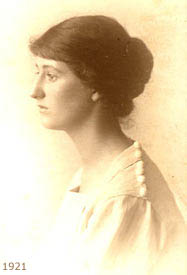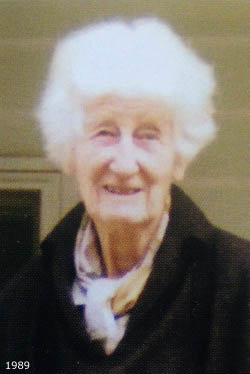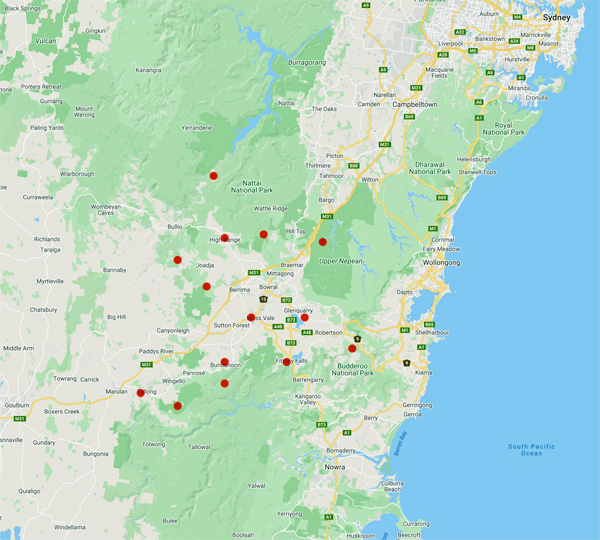
Council of Heads of Australasian Herbaria
Australian National Herbarium
Biographical Notes
 |
Council of Heads of Australasian Herbaria |
 |
 |
Born in Ashfield, Sydney on 21 April, 1901, died 22 October 1989.
The only child of Dr John and Louise ( Calvert) Cosh, Janet attended Normanhurst School for Girls from 1914-1918 and then the University of Sydney where she studied English, History and the Classics. After studying, she taught at Normanhurst School for Girls.
Miss Cosh, a resident of the Southern Highlands of New South Wales, was an educated woman with a variety of interests. Her passion for natural history and botany was inspired by her parents and grandparents. In particular, her maternal grandmother Louisa Atkinson was a botanist, natural historian and writer. Miss Atkinson collected for Rev. Dr W. Woolls and F. Mueller until her untimely death in 1872. Examples of her work are held in the Mitchell Library and National Herbarium of NSW.
In the late 1960s, after spending many years documenting the history of her local area, Miss Cosh, by then nearly 70 years of age, turned her energies to the study of botany. During the next 17 years, Miss Cosh made significant contributions to plant taxonomy providing a rigorous basis for understanding the ecology and biodiversity of many native species of flora in the Southern Highlands of New South Wales. As an amateur botanist, she was highly respected and was often in consultation with professional organisations such NSW National Parks & Wildlife Service and taxonomists at the National Herbarium of NSW, the Australian National Herbarium and the CSIRO. Many examples of letters exchanged with these authorities from prominent personnel such as L.A.S. Johnson, J. Armstrong, J.D. Briggs and D.A. Johnstone still exist as wonderful examples of the polite and lengthy communications by mail in the 1970’s. A number of the letters from the National Herbarium of NSW are in acknowledgement of donations Miss Cosh made over the years to the Royal Botanic Gardens Research Fund.
Miss Cosh’s botanical fieldwork was thorough and methodical and her field notes were precise. She was extremely proficient at map readings having been recruited during World War II to locate and map various routes from the coast across the Southern Highlands to the inland. Specimen locations were always recorded clearly and accurately. Range extensions of several species were documented by Miss Cosh, as well as new locations for rare species such as Phyllota humifusa , Hakea constablei and Acacia chalkeri. Each specimen was identified by Miss Cosh using various keys such as the Flora of the Sydney Region (a copy of which she split in half for ease of carrying in the field) and by consulting with the National Herbarium of NSW. She amassed a collection of botanical books and maps that are annotated prolifically and, succinctly.
Miss Cosh had a keen interest in the ecology of plants and with her friend, Rachelle Roxbourgh, compiled a series of vegetation and fire history maps for Morton National Park. She was an environmentalist and contributed to the establishment of Cecil Hoskins Reserve, Stingray Swamp and Robertson Nature Reserve. Miss Cosh compiled many species lists which have been included in natural history booklets and publications relevant to the Southern Highlands in particular, Morton Nation Park. Just prior to her death in 1989, Miss Cosh (aged 88) had turned her attentions to the South East Forests of NSW making several trips to the area with her friend Rachelle to document the impact of forestry practices in that region.
On her death, Miss Cosh bequeathed funds and resources to the University of Wollongong to establish a regional Herbarium. Her hope was to facilitate botanical research, teaching, expertise in plant identification and the management of native vegetation in a regional context. Miss Cosh’s botanical contributions which have been collated and preserved include an herbarium of 1,600 specimens, nearly 2,000 botanical illustrations, a library, numerous field notebooks, photographs, vegetation surveys and maps. Her collections included excellent examples of recycling using envelopes, paper, stocking inserts, old Christmas cards and even the reverse side of her Father’s watercolour paintings to record notes, drawings and mount specimens. A number of her rare books are now stored in the Michael Birt Library, University of Wollongong. Miss Cosh also prepared an herbarium for the staff at Morton National Park and bequeathed funds to the National Park Foundation some of which were used to establish the Janet Cosh Room at the Fitzroy Falls Visitors Centre as an education resource for the community.
Miss Cosh’s botanical illustrations and plant specimens provide meticulous details of plants and their environment. The data she systematically recorded in the field is still being used as a taxonomic reference to assist with plant identification and to record new information. The herbarium now holds over 10,000 specimens and facilitates the teaching of undergraduate students, provides support for post graduate students and research staff and has inter-departmental links, for example with the Faculty of Creative Arts and the Buildings and Grounds Department. A Campus Tree Walk of over 40 trees has been utilised by many social and educational groups. It contributes to the wider community by providing facilities for the use of regional Government agencies, information for community based environmental groups and has recently established a collaborative agreement with the Wollongong Botanic Gardens.
Miss Cosh is an example of a large group of women from her era who, with independent means and a keen interest in natural history, have contributed to our knowledge of science in a quiet but significant way.
See also: www.uow.edu.au/science/biol/icb/herbarium/history.html#
Source: Extracted from: ASBS Newsletter No.137, December 2008, article by Jean Clarke and Belinda Pellow.
Clarke, J. and Haynes, A. (2012) The Botanical Legacy of Janet Cosh, University of Wollongong, NSW
Portrait Photos: 1921 Tesse Teggart Studios; 1989 Hugh Clarke; extracted from above book.
Data from 24 specimens
